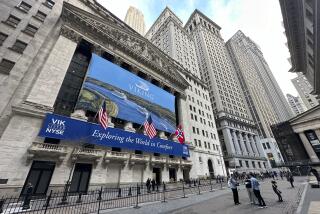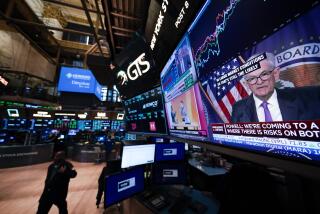Fed Decides Not to Raise Interest Rates Again : Economy: Analysts warn of another increase soon. Some businesses, which saw overtightening, express relief.
WASHINGTON — Ending weeks of speculation, the Federal Reserve Board decided Tuesday not to raise interest rates for the sixth time this year, but experts cautioned that another increase is probably not far off.
In a terse statement, the nation’s central bank said a meeting of the Federal Open Market Committee, a key Fed panel, “ended at 1 p.m. There will be no further announcements.”
Some business spokesmen welcomed the inaction by the Fed, which has been raising interest rates to keep the economy from overheating and sparking inflation. “We are thrilled the Fed has decided to wait until the picture is clearer on inflation and growth,” said Jerry Jasinowski, president of the National Assn. of Manufacturers.
“Our people feel inflation is not accelerating,” he said. “The Fed wisely decided not to make a decision about an issue where they are unclear.”
But Martin Regalia, the U.S. Chamber of Commerce’s chief economist, said he would be “flabbergasted” if the Fed does not raise rates again before November. Regalia speculated that the open market committee on Tuesday may have given Fed Chairman Alan Greenspan the authority to raise rates before the panel meets again Nov. 15.
Corporations are fearful that the Fed risks tightening too much. Mortgage rates have already climbed past 8%, putting a crimp in the housing market. But the bond markets demand aggressive action. Inflation eats away at the value of bonds and other financial instruments.
Indeed, investors reacted to the Fed’s lack of action Tuesday by driving market rates up even higher. The yield on the 30-year Treasury bond rose to a 27-month high of 7.84%, up from 7.79% on Monday, indicating that investors also believe more rate increases are coming.
The Fed could use almost any reason to justify a new round of rate hikes: an unusual surge in jobs during the next employment report, a burst in retail or wholesale prices, a sudden slump in stock prices or a spurt on bonds yields.
“I suspect they have opted to wait and see what the economic data look like over the next couple of weeks,” said Gary Schlossberg, vice president of Wells Fargo Bank.
“The odds favor a move sometime in October,” he said.
The Fed members “are a bunch of people who have made up their minds” to impose further rate increases, said Jeff Faux, president of the Economic Policy Institute, a liberal think tank.
*
“It smells like they are holding it for the employment numbers or for the (current) Japan trade negotiations to fall through or for something else to blame it on,” he said.
The September jobless report is scheduled to be released Oct. 7, and the size of the job growth will be viewed as a key measure of the health of the economy. While a sharp increase in new jobs would indicate the national economy is expanding, Fed members would probably see the increase as an ominous sign that the economy is overheating.
However, Rudy Oswald, chief economist of the AFL-CIO, argued that the Fed has already tightened too much, noting that real wages of workers after inflation are slightly below those of a year ago, while job totals in construction and manufacturing are still lagging behind the pre-recession level of 1990.
Many labor leaders, business executives and politicians see the Fed as an excessively conservative institution, whose actions to restrain credit have damaged the economy’s healthy growth.
The Fed has raised rates five times this year, with the most recent increase coming Aug. 16, when the discount rate--the rate charged to banks for borrowing from the Fed--was boosted to 4% from 3.5%. At the same time, the federal funds rate--the interest banks charge each other for overnight loans--rose to 4.75% from 4.25%.
These higher rates make business more costly at all levels, forcing companies to pay more to finance their activities ranging from building a new plant to obtaining a line of credit for buying merchandise.
Since the Fed began raising rates in February, the prime rate has climbed to 7.75% from 6%. Many consumer and mortgage loans are also tied to the prime--a benchmark rate that banks charge their most credit-worthy customers.
*
The Fed could feel more freedom to raise rates again after the November elections, to avoid having its policies become embroiled in congressional campaigns, noted Marco Budgyk, managing director at Houlihan Lokey Howard & Zukin, a Los Angeles investment management firm.
“There are always politicians who want to remove the independence of the Fed,” he said. “Unless the Fed feels the case is compelling, unless there is overwhelming evidence, they probably won’t do anything until November.”
* MARKET REACTION
Long-term bond yields shot up after Fed’s decision. D3
More to Read
Inside the business of entertainment
The Wide Shot brings you news, analysis and insights on everything from streaming wars to production — and what it all means for the future.
You may occasionally receive promotional content from the Los Angeles Times.










